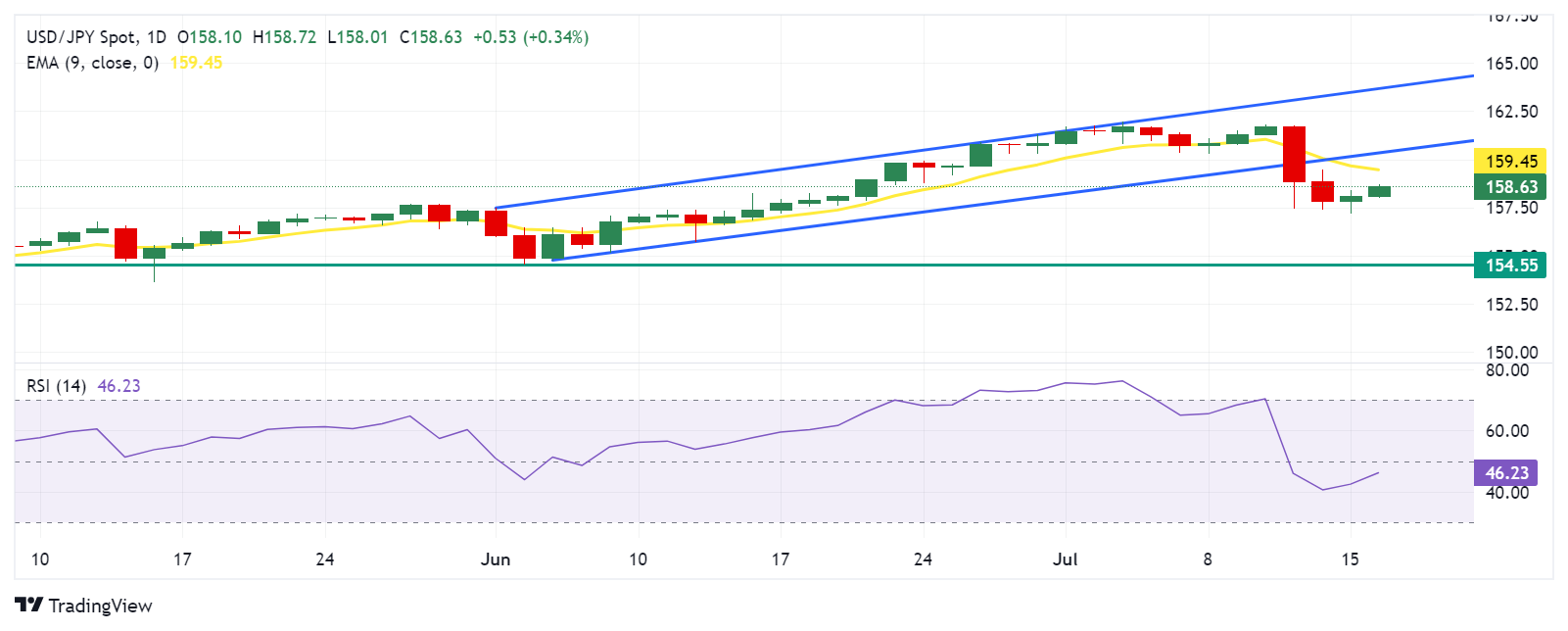- The Japanese Yen could limit its downside as traders remain alert to potential intervention by authorities.
- BoJ data showed that authorities might have spent between ¥3.37 trillion and ¥3.57 trillion on Thursday to support the JPY.
- Fed Chair Jerome Powell mentioned that inflation is on course to meet the Fed’s target sustainably.
The Japanese Yen (JPY) extends its losses on Tuesday with traders remaining on alert after the currency surged about 2% last week on a suspected intervention by Japanese authorities. According to data released by the Bank of Japan (BoJ) on Friday, it's estimated that Japanese authorities may have spent between ¥3.37 trillion to ¥3.57 trillion on Thursday to stem the rapid depreciation of the JPY, as reported by Reuters.
The US Dollar (USD) strengthens amid rising risk aversion triggered by the attempted assassination of former US President Donald Trump on Saturday. However, cooling US inflation strengthened bets for a Federal Reserve rate cut in September, which may limit the upside of the Greenback. Investors will likely observe the US June Retail Sales data, which are set to be released on Tuesday, for further insights.
According to CME Group’s FedWatch Tool, markets now indicate an 85.7% probability of a 25-basis point rate cut at the September Fed meeting, up from 71.0% a week earlier.
Daily Digest Market Movers: Japanese Yen declines despite intervention threats
- Fed Chair Jerome Powell mentioned on Monday that the three US inflation readings of this year "add somewhat to confidence" that inflation is on course to meet the Fed’s target sustainably, suggesting that a shift to interest rate cuts may not be far off.
- Fed Bank of San Francisco President Mary Daly stated that inflation is cooling down in a way that bolsters confidence that it’s on its way to 2%. However, Daly added that more information is needed before making a rate decision.
- US President Joe Biden on Monday addressed the nation from the White House, where he condemned all political violence and called for unity, according to CNBC. Biden further stated that “it’s time to cool it down” and noted not just the weekend attack on Trump but also the possibility of election-year violence on multiple fronts.
- ING’s FX analyst Francesco Pesole observes that Japan’s Ministry of Finance has adjusted its FX intervention strategy. Following the soft US CPI print on Friday, the USD/JPY pair declined approximately 2%, a larger drop compared to other USD pairs. The increase in JPY futures volumes appears to align with indications of FX intervention.
- UBS FX strategists observe that speculative investors hold near-record short positions on the Yen. They suggest that if US economic data continues to indicate a soft landing, USD/JPY could experience periods of pullbacks.
- BBH FX strategists highlight that recent softness in US data poses challenges to their perspective that the backdrop of sustained inflation and strong growth in the US largely remains intact. They note increasing concern among Federal Reserve officials regarding weaknesses in the labor market.
- Japanese Chief Cabinet Secretary Yoshimasa Hayashi stated his readiness to employ all available measures regarding forex. Hayashi noted that the Bank of Japan (BoJ) would determine the specifics of monetary policy. He expects the BoJ to implement appropriate measures to sustainably and steadily achieve the 2% price target, reported by Reuters on Friday.
- On Friday, Japanese Finance Minister Shunichi Suzuki emphasized that rapid foreign exchange (FX) movements are undesirable. Suzuki refrained from commenting on FX intervention and declined to address media reports regarding Japan's FX rate checks, as reported by Reuters.
Technical Analysis: USD/JPY breaks above 158.50
USD/JPY trades around 158.70 on Tuesday. The daily chart analysis indicates a reinforcement of the bullish bias as the pair rises toward the lower boundary of an ascending channel pattern. The 14-day Relative Strength Index (RSI) is also slightly below the 50 level. A further increase could strengthen the bullish trend.
The immediate resistance is observed around the nine-day Exponential Moving Average (EMA) at 159.46, followed by the lower boundary of the ascending channel around 160.30. A return to trading within the ascending channel would likely improve sentiment for the USD/JPY pair, with a potential target toward the upper boundary of the ascending channel near 163.70.
On the downside, the USD/JPY pair could find key support around the psychological level of 158.00. A break below this level could exert pressure on the pair to navigate the region around June's low at 154.55.
USD/JPY: Daily Chart
Japanese Yen FAQs
The Japanese Yen (JPY) is one of the world’s most traded currencies. Its value is broadly determined by the performance of the Japanese economy, but more specifically by the Bank of Japan’s policy, the differential between Japanese and US bond yields, or risk sentiment among traders, among other factors.
One of the Bank of Japan’s mandates is currency control, so its moves are key for the Yen. The BoJ has directly intervened in currency markets sometimes, generally to lower the value of the Yen, although it refrains from doing it often due to political concerns of its main trading partners. The current BoJ ultra-loose monetary policy, based on massive stimulus to the economy, has caused the Yen to depreciate against its main currency peers. This process has exacerbated more recently due to an increasing policy divergence between the Bank of Japan and other main central banks, which have opted to increase interest rates sharply to fight decades-high levels of inflation.
The BoJ’s stance of sticking to ultra-loose monetary policy has led to a widening policy divergence with other central banks, particularly with the US Federal Reserve. This supports a widening of the differential between the 10-year US and Japanese bonds, which favors the US Dollar against the Japanese Yen.
The Japanese Yen is often seen as a safe-haven investment. This means that in times of market stress, investors are more likely to put their money in the Japanese currency due to its supposed reliability and stability. Turbulent times are likely to strengthen the Yen’s value against other currencies seen as more risky to invest in.
Information on these pages contains forward-looking statements that involve risks and uncertainties. Markets and instruments profiled on this page are for informational purposes only and should not in any way come across as a recommendation to buy or sell in these assets. You should do your own thorough research before making any investment decisions. FXStreet does not in any way guarantee that this information is free from mistakes, errors, or material misstatements. It also does not guarantee that this information is of a timely nature. Investing in Open Markets involves a great deal of risk, including the loss of all or a portion of your investment, as well as emotional distress. All risks, losses and costs associated with investing, including total loss of principal, are your responsibility. The views and opinions expressed in this article are those of the authors and do not necessarily reflect the official policy or position of FXStreet nor its advertisers. The author will not be held responsible for information that is found at the end of links posted on this page.
If not otherwise explicitly mentioned in the body of the article, at the time of writing, the author has no position in any stock mentioned in this article and no business relationship with any company mentioned. The author has not received compensation for writing this article, other than from FXStreet.
FXStreet and the author do not provide personalized recommendations. The author makes no representations as to the accuracy, completeness, or suitability of this information. FXStreet and the author will not be liable for any errors, omissions or any losses, injuries or damages arising from this information and its display or use. Errors and omissions excepted.
The author and FXStreet are not registered investment advisors and nothing in this article is intended to be investment advice.
Recommended content
Editors’ Picks

EUR/USD remains pressured below 1.0800 on renewed USD strength
EUR/USD stays under pressure and declines toward 1.0750 following Thursday's recovery. A renewed US Dollar uptick and a cautious mood weigh on the pair, as traders digest the Trump win and the Federal Reserve's monetary policy announcements.

GBP/USD holds lower ground near 1.2950 amid tepid risk sentiment
GBP/USD trades in negative territory at around 1.2950 in the second half of the day on Friday. The emergence of dip-buying in the US Dollar and a tepid risk tone undermine the pair. The BoE’s cautious rate cut could check the pair's downside as traders comments from central bankers.

Gold fluctuates below $2,700 amid stronger USD, positive risk tone
Gold trades below $2,700 in the early American session on Friday and is pressured by a combination of factors. Hopes that Trump's policies would spur economic growth and inflation, to a larger extent, overshadow the Fed's dovish outlook, which, in turn, helps revive the USD demand.

Week ahead – US CPI to shift market focus back to data after Trump shock
After Trump comeback, normality to return to markets with US CPI. GDP data from UK and Japan to also be important. But volatility to likely persist as markets assess impact of Trump.

October’s US CPI rates to be the next big test for the greenback
With the US elections being over, Trump getting elected and the Fed having released its interest rate decision, we take a look at what next week has in store for the markets. On the monetary front a number of policymakers from various central banks are scheduled to speak at some point or the other.

Best Forex Brokers with Low Spreads
VERIFIED Low spreads are crucial for reducing trading costs. Explore top Forex brokers offering competitive spreads and high leverage. Compare options for EUR/USD, GBP/USD, USD/JPY, and Gold.
